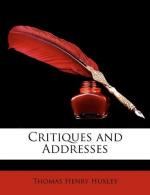Substitute “cosmic vapour” for “clock,” and “molecules” for “works,” and the application of the argument is obvious. The teleological and the mechanical views of nature are not, necessarily, mutually exclusive. On the contrary, the more purely a mechanist the speculator is, the more firmly does he assume a primordial molecular arrangement, of which all the phenomena of the universe are the consequences; and the more completely is he thereby at the mercy of the teleologist, who can always defy him to disprove that this primordial molecular arrangement was not intended to evolve the phenomena of the universe. On the other hand, if the teleologist assert that this, that, or the other result of the working of any part of the mechanism of the universe is its purpose and final cause, the mechanist can always inquire how he knows that it is more than an unessential incident—the mere ticking of the clock, which he mistakes for its function. And there seems to be no reply to this inquiry, any more than to the further, not irrational, question, why trouble oneself about matters which are out of reach, when the working of the mechanism itself, which is of infinite practical importance, affords scope for all our energies?
Professor Haeckel has invented a new and convenient name, “Dysteleology,” for the study of the “purposelessnesses” which are observable in living organisms—such as the multitudinous cases of rudimentary and apparently useless structures. I confess, however, that it has often appeared to me that the facts of Dysteleology cut two ways. If we are to assume, as evolutionists in general do, that useless organs atrophy, such cases as the existence of lateral rudiments of toes, in the foot of a horse, place us in a dilemma. For, either these rudiments are of no use to the animal, in which case, considering that the horse has existed in its present form since the Pliocene epoch, they surely ought to have disappeared; or they are of some use to the animal, in which case they are of no use as arguments against Teleology. A similar, but still stronger, argument may be based upon the existence of teats, and even functional mammary glands, in male mammals. Numerous cases of “Gynaecomasty,” or functionally active breasts in men, are on record, though there is no mammalian species whatever in which the male normally suckles the young. Thus, there can be little doubt that the mammary gland was as apparently useless in the remotest male mammalian ancestor of man as in living men, and yet it has not disappeared. Is it then still profitable to the male organism to retain it? Possibly; but in that case its dysteleological value is gone.
II. Professor Haeckel looks upon the causes which have led to the present diversity of living nature as twofold. Living matter, he tells us, is urged by two impulses: a centripetal, which tends to preserve and transmit the specific form, and which he identifies with heredity; and a centrifugal, which results from the tendency of external conditions to modify the organism and effect its adaptation to themselves. The internal impulse is conservative, and tends to the preservation of specific, or individual, form; the external impulse is metamorphic, and tends to the modification of specific, or individual, form.




